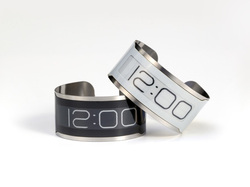Watch Mechanisms
|
Curious about where the watch mechanisms used to decorate the jewelry pendants come from? Here is a photo of the inner workings of a watch. Watch wheels make interesting additions to vintage jewelry, steampunk and Neo-Victorian art. Apparently at some point Swiss jewelers were forbidden to make jewelry which resulted in the beautiful crafting of watches instead. There are many necklace pendants created with the entire watch mechanism as the focal point. These pieces can be intriguingly stunning. The photos below from lifeartworks.com are lovely examples of how the mechanism of a watch can be such a striking piece of art.
Photos courtesy of http://www.lifeartworks.com/beauty-mechanisms-watches/
|
Lime Cola

Ripples With Time mounts vintage watch faces on original Lime Cola bottle caps from the 1940's. The caps' coloration makes an appealing backdrop for the whimsical watch pendants and acts as a unique vintage bezel for the jewelry pieces.
Clock Faces
|
When clocks were first created, they were, sadly, faceless. Mechanical clocks from 13th century Europe were used to ring bells in public towers to call people to prayer. It wasn't until later that someone realized these same mechanisms could be used to turn a hand that everyone could see. These first clocks only had one hour hand and it didn't move. Instead, the fixed hand pointed to numbers that rotated around it. The photo to the right shows a rotating dial clock from St. Mary's Church in Gdansk, Poland. Around the late 14th century, the hands started rotating and the numbers remained fixed. It wasn't until 1690, however, that the minute hand appeared on clocks and even then, many clocks continued to appear with only an hour hand until around 1820. The clock below is an example of a one-handed clock in Groombridge, Kent, at the St. John the Evangelist Church.
|
What's Your Pendant Preference? Vintage Watch Faces With Roman Numerals or Numbers?
Shadow Wall Clocks: Beyond Vintage? Beyond Watch Faces!
Can't decide what clock face is the most appealing? Go back to the days of telling time with sundials and tree shadows courtesy of a modern shadow clock. Engineered by Hanhsi Chen and Chiyu Chen, there are no numbers and no face, just a clock movement, light bulb and a big wall for the shadows.
|
The Time Vision Shadow Wall Clock to the right is currently for sale, but there appears to be no word on how to purchase the Shadow Clock above.
|
World's Thinnest Watch Face?

It's not vintage. It's not filled with days-gone-by charm. In fact, it's cutting edge, high tech and undoubtedly expensive. Looking like a cross between Wonder Woman's bracelets and a hospital admissions tag, this ultra-thin watch gives an interesting alternative to tradition. Called the CST-01, the watch is embedded in a single piece of stainless steel and is, apparently, flexible. There aren't any knobs or dials or buttons to mar its sleek look. All of that work is done on a base station that comes with the watch. Putting the watch on this base for 10 minutes will also charge your timepiece, and that single charge will last an entire month. It's powered by a Thinergy "Micro-Energy Cell" which can be recharged up to 10,000 times for 15 years. The time keeping is courtesy of a Seiko Epson Microcontroller and the whole things weighs about as much as five pennies. It doesn't go into production until September of 2013, but there are many pre-orders already taken. Nathan Fillion has tweeted his approval so steampunk fans everywhere have a reason sign up for their piece of the future.
Horology
Horology is the art or science of measuring time. Clocks and watches are examples of instruments used to measure time. Vintage watch face jewelry are a wonderful way to enjoy the beauty of these instruments!
National Watch & Clock Museum

In Lancaster County, Pennsylvania near Washington DC, there is a museum devoted entirely to clocks. Opened in 1977, the museum boasts over 12,000 items and is the largest, most comprehensive horological collection in the world.







